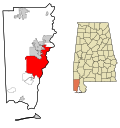Common Street District | |
| Location | Mobile, Alabama |
|---|---|
| Coordinates | 30°41′14″N88°3′27″W / 30.68722°N 88.05750°W |
| Architectural style | Greek Revival, Italianate |
| NRHP reference No. | 82002058 [1] |
| Added to NRHP | February 4, 1982 |
The Common Street District is a historic district in Mobile, Alabama. It is composed of seventeen residences from 959 to 1002 Dauphin Street and 7 to 19 Common Street, primarily featuring examples of Greek Revival, Italianate, and Queen Anne style architecture. [2] It was added to the National Register of Historic Places on February 4, 1982. [1] The district was later absorbed into the much larger Old Dauphin Way Historic District.








